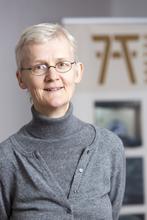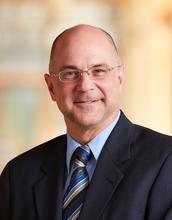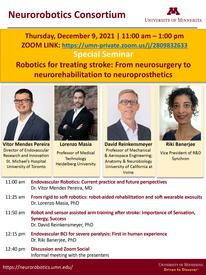
Colloquium Schedule

Imaging the cerebellar nuclei in ataxia
Dagmar Timmann
Professor, Department of Experimental Neurology University of Duisburg-Essen
Friday, November 18, 2022, at 11:00 am - 12:00 pm
109 Cooke Hall

Development and testing of wearable technologies for improving goal-directed movement after stroke
Robert Scheidt
Professor, Department of Biomedical Engineering
Marquette University
Thursday, August 25, 2022, at 11:00 am - 12:30 pm
402 Walter Library

Robotics for treating stroke: From neurosurgery to neurorehabilitation, to neuroprosthetics
Vitor Mendes Pereira
Director, Endovascular Research and Innovation
St. Michael's Hospital, University of Toronto
Lorenzo Masia
Professor, Medical Technology
Heidelberg University
David Reinkensmeyer
Professor, Mechanical & Aerospace Engineering; Anatomy & Neurobiology
University of California at Irvine
Riki Banerjee
Vice President, R&D Synchron
December 9, 2021 at 11-13:00h CST (Zoom)

Using Clinical Data to Drive Clinical Practice: Bringing Practice Change to Scale
Patricia L. Scheets
Vice President of Quality and Clinical Outcomes
Infinity Rehab
November 19, 2021, 1-2 pm
Phillips Wangensteen Building (PWB) Room 2-400

Neuroplasticity and Neuromodulation after Severe Stroke: Teasing Out the Unknowns
Lumy Sawaki
Associate Professor, Department of Physical Medicine and Rehabilitation
CHRH SCI Endowed Chair
College of Medicine, University of Kentucky
April 22, 2019

Leading with Cancer Rehabilitation to Improve Survivorship Care
Nicole Stout
CEO, 3e Services
Consultant
Office of Strategic Research, Dept of Rehabilitation Medicine
National Institutes of Health
November 16, 2018

Mitigating Biomechanical Analyses of Human Movement and the Implications for Clinical Interventions
Richard Neptune
Department Chair and Professor
John T. MacGuire Professorship in Mechanical Engineering
University of Texas, Austin
April 25, 2018

Improvement of Gait and Balance Function in Patients with Peripheral Neuropathy Using a Wearable Sensory Prosthesis
Lars Oddsson
Faculty, Technology Leadership Institute, U of M
President & Co-Founder, RX Function Inc.
October 23, 2017

The cerebellum and learning – focus on eyeblink conditioning in humans
Dagmar Timmann
Associate Professor of Experimental Neurology
Department of Neurology
University Clinic Essen, Germany
June 5, 2017